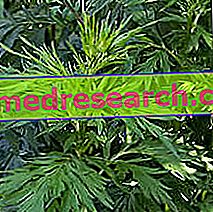
Scientific name
Artemisia vulgaris L.Family
Asteraceae (Compositae)Origin
Europe
Synonyms
Wild wormwood
Used Parts
The leaves, the root and the flowering tops are usedChemical constituents
- Essential oil rich in terpenes and tuiones;
- Sesquiterpene lactones;
- Flavonoids;
- Bitter substances;
- Tannins.
Artemisia in Herbalist: Property of Artemisia
The mugwort is used to promote digestion and as an antispasmodic to regularize menstrual disorders. However, scientific data on its effectiveness and safety are lacking.
Folk medicine and tradition describe artemisia as a diuretic, bitter-tonic, emmenagogue, antispasmodic, sudoriferous, febrifugal, cholagogue, sedative, anthelmintic, anorectic and digestive plant. In liqueur, artemisia is used in the preparation of bitters.
The decoction is used for vaginal and rectal lavages, in addition it is astringent.
For the anti-tumor properties of artemisia, see the article on artemisinine
Biological activity
Numerous properties are ascribed to artemisia, which are mainly attributed to the essential oil and to the aqueous extract obtained from the plant itself.
Among the different properties that this plant boasts, it is probably the digestive and antispasmodics that are of most interest.
The digestive activity of the artemisia is due to the bitter substances it contains, which act by stimulating gastric secretion.
As for the antispasmodic activity, on the other hand, a study conducted on the raw mugwort extract has shown that it has anticholinergic activity. It is this mechanism of action that could be the basis of the spasmolytic activity attributed to the plant.
However, the scientific evidence currently available is not sufficient for the official approval of the aforementioned applications of artemisia in the medical field.
Artemisia in folk medicine and in homeopathy
Although the use of Artemisia for therapeutic purposes has not been officially approved, this plant is used in folk medicine for the treatment of numerous and varied disorders.
In fact, artemisia is used as a remedy for gastrointestinal disorders, against persistent vomiting and even against epilepsy. Furthermore, this plant is used to reactivate the ceased menstruation, calming the pains that accompany them. And it's not over here. Popular medicine also uses artemisia as an anthelmintic and sedative remedy, as well as a treatment for various psychiatric disorders, including depression, irritability, anxiety and insomnia.
In the homeopathic field, instead, the artemisia is used as a remedy against convulsions, against dermatoses and other skin diseases, against the irregular or abundant menstrual cycle and as a muscle tonic.
Artemisia is readily available in homeopathic preparations in the form of granules. The dose of product to be taken may vary depending on the homeopathic dilution that is used.
Pharmacological Interactions
- bitter;
- hormonal therapies;
- neurostimulant drugs.
Artemisia - Side effects and warnings
Important side effects of the plant are nausea, vomiting, diarrhea and abdominal cramps; allergic reactions (pollinosis) are frequent; avoid pregnancy due to potential abortion; the artemisia is contraindicated in subjects with gastritis, peptic ulcer, epilepsy or hypersensitivity ascertained towards one or more components.
Note
Artemisia is present in different varieties and recognizes a wide use in folk medicine. In traditional Chinese medicine it is used for moxibustion, that is burned on acupuncture needles.
Artemisina is now extracted from Artemisia annua which, with its derivatives, is used as an antimalarial and antitumor drug.
Tarragon ( Artemisia dracunculus L.), called Estragon, is widely used in gastronomy, but there is not enough literature for use for curative purposes; however, it contains an essential oil particularly rich in estragole, a constituent with carcinogenic properties.
Genepì ( Artemisia genipi L.) is instead a typical mountain plant, used by the liqueur industry.



